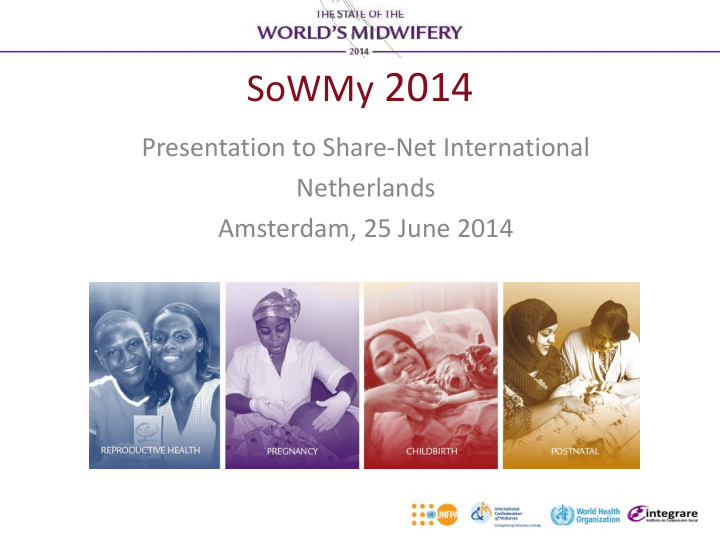



SoWMy 2014 Presentation to Share-Net International Netherlands Amsterdam, 25 June 2014
A message from Ban Ki-moon The midwifery workforce, within a supportive health system, can support women and girls to prevent unwanted pregnancies, provide assistance throughout pregnancy and childbirth, and save the lives of babies born too early. I fully support the Midwifery 2030 vision articulated in this report. This vision is within reach of all countries, at all stages of economic and demographic transition .
SoWMy 2014: Key findings
Effective coverage CRUDE COVERAGE EFFECTIVE COVERAGE AVAILABILITY ACCESIBILITY ACCEPTABILITY QUALITY Midwifery workforce is Midwifery workforce is Midwifery workforce is Midwifery workforce AVAILABLE ? ACCESSIBLE ? ACCEPTABLE ? provides QUALITY CARE ? • • Woman attends • A midwife is available in Woman attends • Woman attends or close to the community • • A midwife is available A midwife is available • A midwife is available • As part of an integrated • team of professionals, lay As needed • As needed workers and community • As needed • health services Providing respectful care • Financial protection ensures no barriers to • Competent and enabled to • Providing respectful care access provide quality care. Source: Campbell J. SoWMy 2014
Availability • The availability of the midwifery workforce can only be measured by reference to full-time equivalent not headcount. • Midwifery education must be actively managed to ensure that the future workforce meets the needs of future populations. • A career as a midwife is perceived to be more attractive than other professions open to people with a similar level of education, but not in all countries. • Midwives’ salaries are among the lowest for health-care professionals in low- and lower-middle-income countries .
Accessibility • Most countries deploy their midwifery workforce using facility-based planning or workforce to population ratios; these may be inconsistent with needs and access to care. • Human resource information systems linked to facility GIS codes would enable new insights into people’s ability to access a skilled and competent health-care provider. • Countries are urged to develop a “minimum guaranteed benefits package ” for SRMNH. • 70 of the 73 responding countries have a national “minimum guaranteed benefits package”, but there are gaps in the essential interventions. • Many countries will face significant challenges Source: WHO and World Bank, SoWMy 2014 to ensure universal coverage, especially for the poorest 40%.
Acceptability
Quality • Key challenges for quality midwifery education include the inadequacy of secondary education, lack of teaching staff, poor quality equipment, lack of opportunities for practical training and lack of classroom space. • The number of births a midwife conducts under supervision prior to graduation varies across countries, and may be insufficient to meet competency requirements. • Nearly all responding countries have at least one regulatory body, but many lack legislation recognizing midwifery as a regulated profession, clearly described midwifery competencies and education standards, and effective regulatory processes. • Nearly all countries reported having at least one professional association open to midwives. • 75% of countries said the SRMNH workforce targets in their HRH plans was linked to the national SRMNH or health plan.
Country briefs
Kenya Case Study
Kenya Case Study Projected outflows + Projected Inflows to 2030
Kenya Case Study
Kenya Case Study
Chad Case Study
Chad Case Study Projected outflows + Inflows From 2012 to 2030
Chad Case Study
Chad Case Study
PLANNING AND PREPARING SUPPORTING A SAFE BEGINNING ENSURING A HEALTHY START CREATING A FOUNDATION FOR THE FUTURE
The Midwifery2030 vision – key points 1. All women of reproductive age, including adolescents, have universal access to midwifery when needed. 2. Governments provide and are held accountable for a supportive policy environment. 3. Governments and health systems provide and are held accountable for a fully enabled environment. 4. Data collection and analysis are fully embedded in service delivery and development. 5. Midwifery care is prioritized in national health budgets; all women are given universal financial protection.
The Midwifery2030 vision – key points (cont.) 6. Midwifery care is delivered in collaborative practice with health-care professionals, associates and lay health workers 7. First-level midwifery care is close to the woman and her family with seamless transfer to next-level care. 8. The midwifery workforce, in communities, facilities and hospitals, is supported through quality education, regulation and effective human and other resource management. 9. All healthcare professionals provide and are accountable for delivering respectful, quality care. 10. Professional associations provide leadership to their members to facilitate quality care through collaboration
Recommend
More recommend